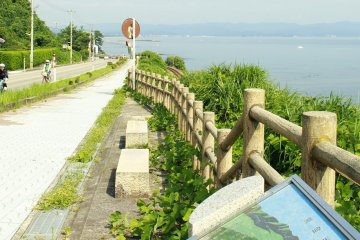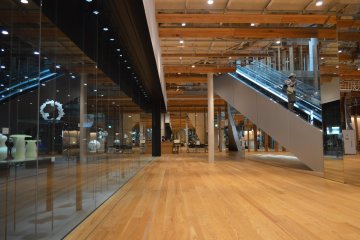Toyama Prefecture is a land of stunning natural beauty, rich history, traditional crafts, and vibrant festivals. The Manyoshu, Japan’s earliest collection of waka poetry, captures the essence of this region through its evocative descriptions. Compiled by the renowned poet, Otomo-no-Yakamochi, the breathtaking landscapes portrayed in the Etchu Manyo poems are still visible today. Through this literary tour of ‘Deep Toyama’, follow in Yakamochi’s footsteps, uncovering the timeless charm of this culturally rich prefecture.
Meet Your Expert Guide
Your guide, Ai Nishimura, is a seasoned writer with a passion for uncovering Japan’s local stories and traditions. With years of experience writing about Japan’s cultural heritage and a love for the Manyoshu, Ai Nishimura is the perfect guide to bring this literary journey to life.
Highlights of the Tour
- Discover the Manyoshu at the Koshinokuni Museum of Literature & Takaoka City Manyoshu History Museum
- Visit Hōjōzu Hachimangu: A shrine loved by Otomo-no-Yakamochi
- Walk in the Footsteps of Otomo no Yakamochi in Fushiki, Takaoka City
- Stroll Along the Scenic Ecchu Hamamou-roi, and Indulge in Sweet Delights
Discover the Manyoshu at the Koshinokuni Museum of Literature & Takaoka City Manyoshu History Museum
For five years in the mid-700s, Otomo-no-Yakamochi served as the provincial governor of Etchu (modern-day Toyama), during which time he composed many poems and helped edit the Manyoshu’s over 4,500 entries.
The Etchu Manyo collection of poems richly describes the life, love, events, and scenery of former Etchu Province, resonating deeply with the people of Takaoka, who cherish Yakamochi’s poetic legacy to this day. Perhaps Yakamochi composed his poems in the same fashion that we write our thoughts and ideas on X (formerly Twitter) today, by closely studying the experiences and events of his travels, the lives of the people he came in contact with, and the inspirational scenery he witnessed.
Begin your journey in Takaoka, where two wonderful museums await to introduce the world of the Manyoshu. The Koshinokuni Museum of Literature offers a comprehensive look at Toyama’s rich literary tradition. Enjoy interactive exhibits, including Manyo Tobashi, a hands-on experience that combines visual imagery and poetry recitations to bring Yakamochi’s world to life. Seasonal paintings that reflect the Manyoshu’s references to Toyama’s natural beauty are also on display.

At the Takaoka City Manyoshu History Museum, the first museum in Japan dedicated to the Manyoshu, you’ll find priceless artifacts, manuscripts, and even traditional Manyo costumes. The immersive experience continues with projection mapping and an impressive garden featuring seasonal Manyo plants. This museum is a treasure trove of insights into the ancient poems that shaped Toyama's identity.
Koshinokuni Museum of Literature: https://www.koshibun.jp/
Takaoka City Manyoshu History Museum: https://www.manreki.com/
Visit Hōjōzu Hachimangu: A shrine loved by Otomo-no-Yakamochi
Yakamochi had a deep affection for the coastline of Nago-no-ura, now part of Imizu City. Not only did he write about its beauty, but he also built Hōjōzu Hachimangu here as a testament to his devotion to the land and its people. The shrine features impressive zelkova wood guardian lion-dog statues and boasts a haiku monument to the renowned poet Matsuo Basho, who visited Etchu to follow in Yakamochi’s footsteps.
Hojozu Hachimangu: https://www.houjyoudu.com/

Nearby, the port town atmosphere of the Uchikawa district of Shinminato, often referred to as the ‘Venice of Japan’ due to its charming canals and fishing boats, is well worth exploring. Just a few minutes away, the Kaio Maru, a majestic sailing ship turned maritime museum, offers insight into Toyama’s seafaring history.
If you visit in autumn, don’t miss the shrine’s annual festival, Mikoshi Todogyosai, whose origins date back to the Edo Period (1603-1868). Thirteen impressive traditional floats are paraded through town in celebration of the yearly harvest. This festival, recognized as an Important Intangible Folk Cultural Asset of Japan, is a living testament to Toyama’s enduring traditions.
Walk in the Footsteps of Otomo no Yakamochi in Fushiki, Takaoka City
The journey continues in Fushiki, the town where Yakamochi served as provincial governor. Visit the impressive Shoukouji Temple, designated a National Treasure of Japan, and admire its monument to the Manyoshu. The nearby Takaoka City Meteorological Museum is housed in a historic building from the Meiji Period. This entire area retains a nostalgic atmosphere, offering a glimpse into Yakamochi’s life and work during his time there.
Shoukouji: https://www.shoukouji.jp/

Don’t miss Keta Jinja, a lovely shrine that offers panoramic views of Toyama Bay and the Tateyama mountain range. The dramatic scenery, often reflected in Yakamochi’s poetry, is the perfect place to pause and appreciate the profound connection between nature and poetry.
Keta Jinja: https://ketaweb.net/
Stroll Along the Scenic Ecchu Hamamou-roi, and Indulge in Sweet Delights
The Ecchu Hamamou-roi coastal path is one of the most picturesque parts of the tour, taking the same route Yakamochi once walked as he composed his timeless poems. Beautiful Amaharashi Beach offers one of the most iconic views in Toyama: Onna Iwa, or ‘woman rock’, floating in the sea with the Tateyama Mountains as a backdrop. A special monument on the grounds of the Roadside Station Amaharu allows visitors to immerse themself in a poem while they take in the view of its subject.
Roadside Station Amaharu: https://michinoeki-amaharashi.jp/

Complete the journey in Yamamachosuji, a historic preservation district filled with streets lined with traditional homes and storehouses. Since the Meiji Era (1868-1912), Ohnoya, a renowned Japanese confectionery shop, has created and sold exquisite sweets inspired by the Manyoshu. Their specialty is Tokonatsu, a delicate wagashi made of wasabon, a combination of Japanese lemon and sugar, and white azuki beans. This bite-sized sweet is named after one of Yakamochi’s poems about the snow-capped mountains of Tateyama. The creation of other elegant, handcrafted treats, Takaoka Ramune and Tagoto, were also inspired by the Manyoshu.
Ohnoya: http://ohno-ya.jp/
A Unique Japanese Poetic Experience
For travelers seeking a special, immersive cultural experience, this Deep Toyama Tour offers the perfect opportunity to explore the landmarks and landscapes that inspired Otomo-no-Yakamochi’s poetry. It is a journey that brings ancient verses to life, blending natural beauty with cultural discovery.










